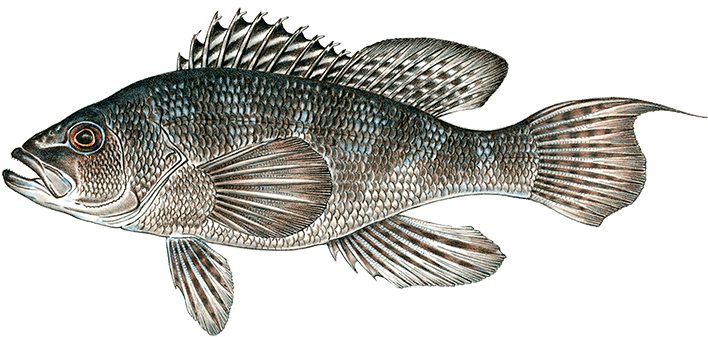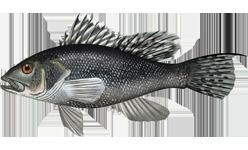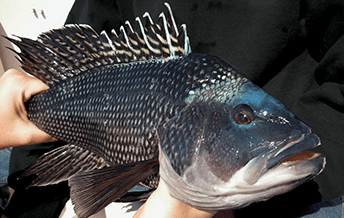Kingdom Animalia Genus Centropristis Mass 2.4 kg (Adult) Rank Species Order Perciformes | Family Serranidae Scientific name Centropristis striata Phylum Chordata Higher classification Centropristis | |
 | ||
Similar Scup, Summer flounder, Tautog, Weakfish, Centropristis | ||
Black sea bass for dinner
The black sea bass (Centropristis striata) is an exclusively marine grouper found more commonly in northern than in southern ranges.
Contents
- Black sea bass for dinner
- Tips and tricks how to catch black sea bass
- Lifecycle
- Identification features
- Management
- International names
- References
It inhabits the coasts from Maine to northeast Florida and the eastern Gulf of Mexico. The three large biomass populations of black sea bass are the mid-Atlantic stock, from Cape Cod in Massachusetts to Cape Hatteras in North Carolina, the South Atlantic stock, from Cape Hatteras to the southern tip of the Florida peninsula, and the Gulf of Mexico stock, from the southern tip of the Florida peninsula to Texas. They can be found in inshore waters (bays and sounds) and offshore in waters up to a depth of 130 m (430 ft). They spend most of their time close to the sea floor and often congregate around bottom formations such as rocks, man-made reefs, wrecks, jetties, piers, and bridge pilings.

Tips and tricks how to catch black sea bass
Lifecycle

The sea bass spawns when it is mature, at 190 mm (7.5 in), in middle of May to end of June. The buoyant eggs are 0.95 mm (0.037 in) in diameter, and their development time is 1.6 days at 23 °C (73 °F). The maximum size of a sea bass is 500 mm (20 in), weighing 4.3 kg (9.5 lb).

It appears off New Jersey in the first weeks of May, withdrawing in late October or early November, and wintering offshore at 55 to 130 m (180 to 427 ft) at temperatures above 8 °C (46 °F). In summer, it is most abundant at less than 37 m (121 ft).

Black sea bass are protogynous hermaphrodites, meaning they generally first mature as females and some later become male. The sex change generally occurs over the winter when the fish are 240 to 330 mm (9.4 to 13.0 in) long.

The world record catch for the black sea bass is 4.65 kg (10 lb 4 oz), caught Virginia Beach, Virginia, USA 01-Jan-2000, by Allan Paschall.
Identification features
It often rests stationary or cruises slowly around structures. It occasionally rests on the bottom or other structures, staying either head-down or head-up. It enters the smallest corners and caves with a body angle above ground often about 40° down. The dorsal fin is normally folded close to the body, and it is only spread out as an aggressive posture reaction to other sea bass.
Management
Black sea bass are highly sought after by recreational and commercial fisherman, and thus can be overfished. Quotas have been set to help limit the overfishing of black sea bass. The mid-Atlantic population is considered "rebuilt", while the south Atlantic population is considered "overfished".
